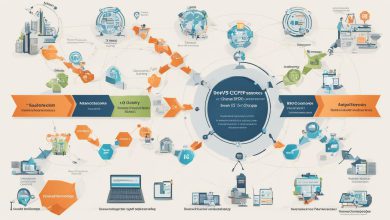
Welcome to our article on Scaling DevSecOps: Best Practices for Large Enterprises. In today’s digital age, organizations of all sizes face significant security challenges. This is especially true for large enterprises, which typically have complex IT environments and face a larger and more sophisticated range of threats.
Developing a secure DevOps process is essential for businesses that want to run efficient and safe software development operations. Implementing best practices for DevSecOps not only ensures security, but also helps organizations to move faster, ultimately driving innovation and enhancing customer satisfaction.
Key Takeaways:
- Scaling DevSecOps practices is crucial for large enterprises with complex IT environments, and it requires proper implementation of best practices.
- Integrating security into the DevOps process is essential for successful management of DevOps and security in large enterprises.
- Automating key aspects of DevSecOps, such as continuous integration and deployment, can help organizations achieve more efficient and secure software development operations.
- Best practices for secure development, such as code review, vulnerability scanning, and secure coding practices, are critical for ensuring safety in a DevSecOps environment.
Managing DevOps and Security in Large Enterprises
Implementing DevOps and security practices in large enterprises can be a complex undertaking. Teams must balance the need for speed and agility with the importance of ensuring the security and stability of their systems. In this section, we will explore strategies for successfully managing DevOps and security in a large-scale environment.
Integrating Security into the DevOps Process
One of the key challenges facing large enterprises is integrating security into their existing DevOps processes. In many cases, security is seen as a separate function, leading to delays and inefficiencies. To overcome this challenge, teams should look to embed security into every stage of the DevOps pipeline. This includes security testing at the code commit stage, automated vulnerability scans during the build process, and ongoing monitoring in production.
By integrating security into the DevOps pipeline, teams can identify and address security issues early in the development process, reducing the risk of security breaches and minimizing the time and cost associated with remediation.
Implementing Security as Code
Another key strategy for managing DevOps and security in large enterprises is to implement security as code. This involves using automation tools and scripts to define and enforce security policies and standards across the organization.
By implementing security as code, teams can ensure that security is baked into their applications and infrastructure from the outset, rather than being bolted on as an afterthought. This approach also helps to ensure consistency and reduces the risk of human error, which can be a significant source of security vulnerabilities.
Cultural Change and Communication
Implementing DevSecOps practices in a large enterprise also requires a cultural shift. Teams must move away from traditional siloed approaches to development and security and adopt a more collaborative mindset. This requires open lines of communication between teams, as well as a willingness to share knowledge and expertise.
By fostering a culture of collaboration and communication, teams can break down silos and ensure that everyone is working towards the same goal – delivering secure, high-quality software at speed.
In conclusion, managing DevOps and security in large enterprises requires a multifaceted approach. Teams must integrate security into the DevOps pipeline, implement security as code, and foster a culture of collaboration and communication. By adopting these strategies, organizations can ensure that they are delivering secure, high-quality software at speed, while minimizing the risk of security breaches.
Scaling DevSecOps Through Automation
Automation is key when it comes to scaling DevSecOps processes. By automating key aspects of the process, such as continuous integration and continuous deployment, organizations can ensure that security is built into every aspect of the development cycle. This not only saves time but also reduces the risk of human error.
One of the most significant advantages of automation is that it allows teams to move quickly while still maintaining a high level of security. Continuous integration and continuous deployment (CI/CD) tools help to streamline the development process by automating many of the manual tasks involved, such as building, testing, and deploying code. When it comes to security, CI/CD pipelines can be configured to run automated security scans at various stages of the development cycle, helping to identify vulnerabilities as early as possible.
Another area where automation can be particularly effective is in managing infrastructure as code. By automating the creation and deployment of infrastructure, organizations can ensure that security is always built-in from the outset. This is achieved by creating templates, known as “Infrastructure as Code” (IAC), that define the resources needed to run an application, along with their configuration settings. Once defined, these templates can be deployed automatically and repeatedly, ensuring consistent and secure infrastructure across all environments.
There are a variety of tools available to help organizations automate their DevSecOps processes. For example, configuration management tools such as Ansible and Puppet can be used to automate the deployment and configuration of applications, while container orchestration tools like Kubernetes can be used to streamline the deployment of microservices.
Ultimately, successful automation of DevSecOps requires a comprehensive approach that addresses both the technical and cultural challenges involved. As well as implementing the right tools and processes, organizations need to foster a culture of security awareness among their teams, ensuring that everyone takes responsibility for security and understands the importance of the DevSecOps approach.
Best Practices for Secure Development in Large Enterprises
Implementing secure development practices is crucial in DevSecOps, especially for large enterprises. Ensuring secure coding practices and vulnerability scanning is a challenge at scale. To address these challenges, organizations must adopt a framework of best practices to promote secure development.
Code Review
Code review involves reviewing and examining source code to identify security issues, bugs, and other vulnerabilities. In large enterprises, it is essential to establish an efficient code review process to ensure secure development practices across teams. Code reviews should be conducted regularly and systematically to maintain code quality and security.
Vulnerability Scanning
Vulnerability scanning is a vital process to detect vulnerabilities in code before deployment. The use of vulnerability scanners can help identify potential security flaws in applications and systems, enabling organizations to take corrective action before a breach occurs. Regular scanning and reporting processes should be established to ensure timely detection and remediation of vulnerabilities.
Secure Coding Practices
Establishing secure coding practices should be a fundamental goal of any DevSecOps initiative. In large enterprises, it is essential to adopt standardized coding practices and development guidelines that promote secure coding. This includes providing education and training programs to developers to equip them with the necessary skills to write secure code.
Organizations should also implement a system of checks and balances to ensure secure coding practices are followed consistently. This can include automated tools, such as static code analysis tools, to detect and prevent insecure coding practices at scale.
Scaling Secure Development Practices
Scaling DevSecOps in large enterprises requires the adoption of secure development practices that can be effectively scaled to meet the organization’s needs. This includes establishing standardized processes, leveraging automation, and providing continuous education and reinforcement of secure coding practices.
Organizations should also prioritize security by design and integrate security features and testing into the development process. By addressing security concerns early in the development cycle, enterprises can reduce the risk of vulnerabilities and breaches.
Overall, implementing best practices for secure development in large enterprises is essential for scaling DevSecOps processes. By prioritizing secure development practices, organizations can ensure the security and reliability of their applications and systems.
Conclusion
Scaling DevSecOps in large enterprises is a complex undertaking that requires a strategic approach and a commitment to implementing best practices. In this article, we have explored the challenges faced by organizations in managing DevSecOps at scale and provided actionable insights and strategies for addressing these challenges.
From integrating security into the DevOps process to leveraging automation and implementing best practices for secure development, there are a range of ways in which organizations can scale their DevSecOps efforts effectively. By doing so, they can not only enhance their security posture, but also improve their ability to innovate and deliver value to their customers.
Ultimately, the key to successfully scaling DevSecOps in large enterprises is to prioritize collaboration, continuous improvement, and a focus on delivering secure, high-quality software. By following these best practices and remaining committed to the principles of DevSecOps, organizations can overcome the challenges of scaling and build a more secure, resilient, and innovative culture.
FAQ
Q: What is DevSecOps?
A: DevSecOps is a software development approach that combines development (Dev), security (Sec), and operations (Ops) to ensure security is integrated into the entire software development lifecycle. It emphasizes collaboration, automation, and continuous security testing to deliver secure and reliable software.
Q: Why is scaling DevSecOps important for large enterprises?
A: Large enterprises often handle complex software systems and face unique security challenges. Scaling DevSecOps allows these organizations to effectively manage security while maintaining high development velocity. It enables efficient collaboration, standardized processes, and ensures security is embedded throughout the organization.
Q: What are some best practices for scaling DevSecOps in large enterprises?
A: Some best practices for scaling DevSecOps in large enterprises include implementing automation, establishing cross-functional teams, integrating security into the development process, conducting regular security assessments, and fostering a culture of security awareness and collaboration.
Q: How can automation help in scaling DevSecOps?
A: Automation plays a crucial role in scaling DevSecOps by reducing manual effort, improving efficiency, and ensuring consistency. Automation can be applied to various areas such as continuous integration, continuous deployment, security testing, vulnerability scanning, and compliance monitoring.
Q: What are the key challenges in managing DevOps and security in large enterprises?
A: Managing DevOps and security in large enterprises can be challenging due to factors such as complexity, cultural resistance to change, coordination across teams and departments, ensuring compliance with regulations and standards, and keeping up with evolving security threats.
Q: How can large enterprises ensure secure development in a DevSecOps environment?
A: To ensure secure development in a DevSecOps environment, large enterprises should follow best practices such as conducting thorough code reviews, implementing vulnerability scanning tools, promoting secure coding practices, providing security training to development teams, and integrating security testing into the CI/CD pipeline.








